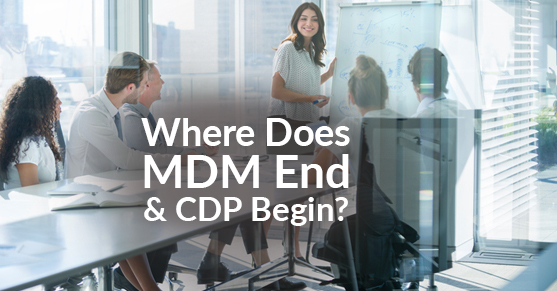The need for data unification and defragmentation is a top priority for organizations with ubiquitous data and siloed sources. As leadership looks for solutions, their focus turns toward Master Data Management (MDM) and emerging Customer Data Platforms (CDP) for addressing the barriers to operational excellence. When these are up for consideration, understanding where one begins and the other ends gets muddled under the euphoria of having control over their data. Even though there’s a point where MDM and CDP meet, a distinct partition exists between them, both in their data and objective.
Defining MDM and CDP
MDM is primarily concerned with the consolidation of data sets to create an encompassing view of all customer information. In other words, a single source of truth for organizations to model their operational maneuvers and drive analytics. Instead of relying on haphazard and disparate data sources, MDM aims to give big data more initiative, defining how it’s structured and consumed within the enterprise. For example, if a company has inconsistent data dispersed throughout multiple systems (be it from acquisitions, numerous stores/locations, legacy technology, etc.), MDM projects enhance data quality, unify disparate data sources, and provide an architecture that positions the organization to make qualified decisions and improve customer experience. As a project, MDM is an organization-wide IT overhaul.
Conversely, a CDP concerns itself with driving marketing initiatives and giving concise direction to marketing campaigns and strategies. CDP software collects marketing data (online session IDs, form fills, cookies, email, IP addresses, and so on) to give marketing teams an idea of who the customers or prospects are, how they’re interacting with the company, and what their interests are to align marketing activities to buyer personas. So, a CDP helps organizations decide how to deliver the right information to the right customer at the right time to improve interactions/conversions.
To give an example, XTIVIA developed an overarching MDM solution for a global car rental company. The organization had an excessive amount of dirty data siloed in numerous sources, and information on prospective customers was insufficiently managed in a legacy CRM system. Ultimately, their environment impeded many business operations and limited their ability to define customer needs and trends and build customer profiles. XTIVIA integrated the client’s entire data ecosystem to create an interconnected data network of trusted data. They were quickly able to build customer profiles (highlighting their rental history, vehicle preference, VIP status, location, etc.) and deliver an exceptional experience to all returning customers and first-time renters. Additionally, the implementation of a cloud-based CRM with CDP functionality gave them the confidence to design precise marketing campaigns and confidently pursue potential customers. (You can read similar success stories here.)
Where Does MDM End and CDP Begin?
What you’ll notice the main difference between MDM and CDP is the type of data they utilize and their objective. The data involved with MDM is well-structured and requires calculated governance programs to develop customer profiles for personalization and build loyalty. It goes beyond the ambitions of marketing objectives and supplies an entire organization (IT teams, sales, support, finance, etc.) with a higher level of confidence in their data. On the other hand, CDP data is relatively scarce and less structured. Instead of having clear customer details, the CDP combines information from specific points of contact with the company and uses it to create predictive analytics. Although marketing teams take the reigns with CDP data, the data is also disseminated to sales teams for sales programs and creating detailed offers.
Regardless of their difference, we can see a similar intent: eradicating data fragmentation by unifying information silos. On both sides, scattered data comes together as a data asset mosaic, improving business decision making, customer experience, and brand loyalty.
So, where exactly does one end and the other begin? Ultimately, a clear boundary is set when a prospect becomes a customer. Once we see a conversion, the once-vague data collected in the CDP becomes refined with distinct details regarding the customer’s identity, transactions, buying habits, etc. As shown in the example from earlier, the organization trades a hazy persona for a comprehensive profile they can use to provide the customer with a personalized experience for every interaction and tailor-made offers for nearly every opportunity.
A Combination in the Works
MDM and CDP are crucial to fulfilling the demands of our IT-centered business climate. While they carry out different tasks, they allow enterprises to actualize the advantages of customer data, and a fusion of the two is emerging to further the possibilities of customer engagement. An MDM-CDP merger could give businesses the power to map out the customer journey more concisely and efficiently for unrivaled revenue streams.
For more information on MDM, CDP, and the advantages they can deliver to your business, feel free to reach out to us here. Our team of seasoned MDM and CDP experts design exceptional data solutions for all industries, and if capitalizing on the benefits of data quality is in the cards for you, we’re here to help.

